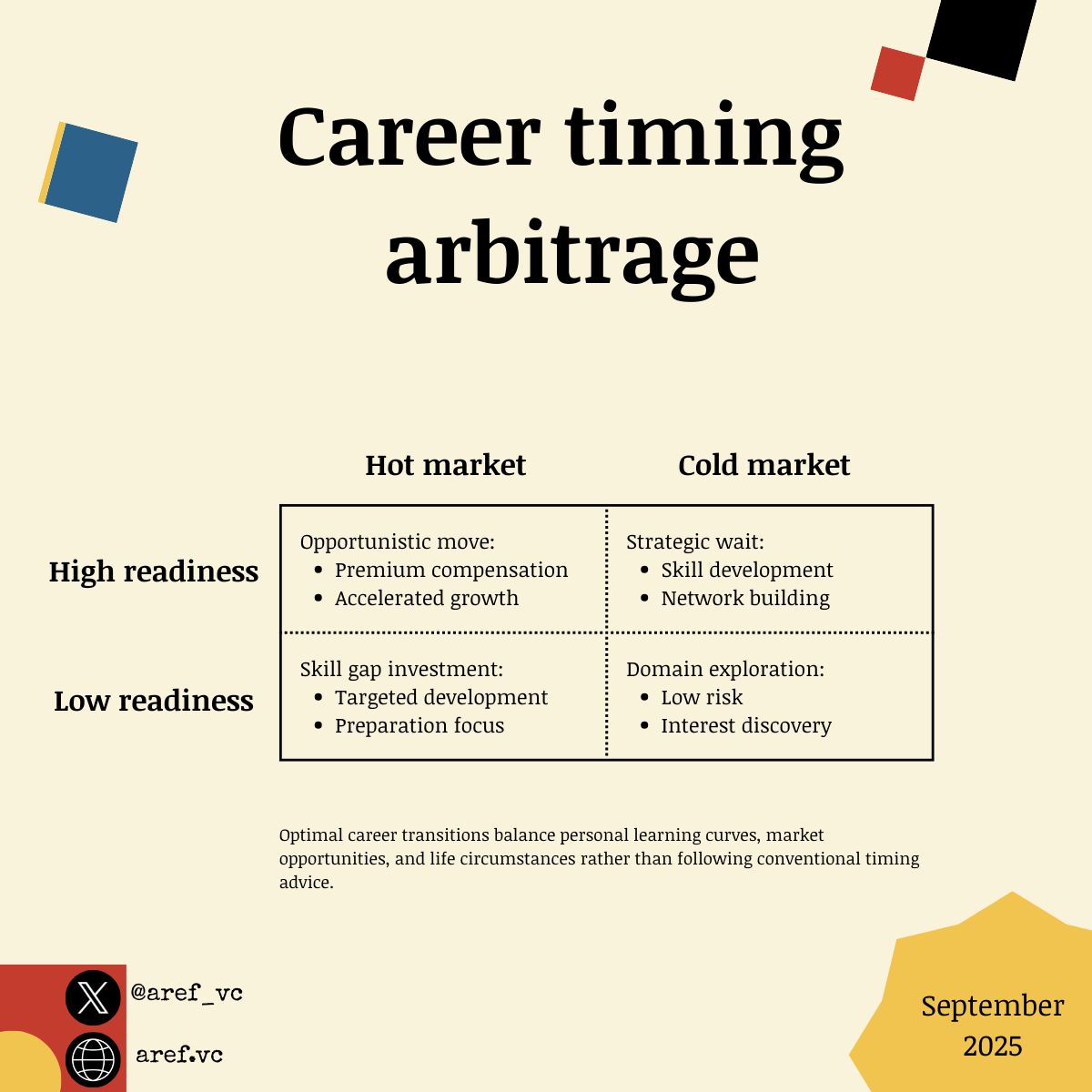Americans change jobs an average of 12 times during their careers, with median job tenure dropping to 3.9 years in 2024—the lowest since 2002 [Source: Bureau of Labor Statistics, 2024]. This reflects a fundamental shift away from traditional linear career paths toward strategic career diversification that creates compound value through skill combination.
Having built teams across multiple industries and observed career patterns throughout scaling organizations, I've consistently seen that the highest-performing leaders combine expertise from seemingly unrelated domains.
Research reveals a counterintuitive professional development truth: Skill diversity creates exponential career value while specialization creates linear advancement with diminishing returns. With 59% of U.S. professionals actively seeking new opportunities in 2024, the ability to leverage diverse skills across domains has become essential [Source: Career mobility research, 2024].
The skill stacking multiplier: How domain combinations create exponential value
Career diversification creates exponential rather than linear returns. Each additional domain creates multiplicative rather than additive value through unique skill combinations that are difficult to replicate through traditional hiring.
It's important to acknowledge that this analysis may reflect selection bias—professionals willing to make career switches may be inherently more adaptable and risk-tolerant. However, controlled studies suggest the skill combination effect is causal rather than correlational.
Framework 1: The skill stacking compound advantage - Why breadth multiplies depth value
Research on skill stacking demonstrates that professionals combining multiple domains significantly outperform single-domain specialists in problem-solving effectiveness and cross-functional collaboration.
The operational mechanism: Skill combinations create unique value propositions that cannot be replicated through hiring multiple specialists, making these professionals irreplaceable rather than replaceable.
Case study from organizational experience: Our highest-performing product manager combined engineering background, customer success experience, and business development skills. This combination enabled technical feasibility assessment, user empathy, and market opportunity recognition that single-domain PMs couldn't match.
Strategic insight: Rare skill combinations command premium compensation because they solve problems that require multiple types of expertise simultaneously. The cybersecurity field exemplifies this—professionals working across multiple security domains earn significantly higher compensation, with security architects averaging $206,000 annually [Source: IANS Research Cybersecurity Staff Compensation Report, 2025].
Implementation framework:
Adjacent skill development: Build capabilities in domains that complement core expertise
Cross-functional project seeking: Volunteer for initiatives requiring skill intersection
Industry boundary crossing: Explore opportunities in adjacent industries
The limitation: Skill stacking requires longer development timelines and may initially appear unfocused to traditional hiring managers.
Framework 2: The adaptability multiplier - Why career uncertainty builds resilience
Research demonstrates that professionals with non-linear career paths show significantly higher adaptability during organizational change and superior performance during industry disruption.
The mechanism: Non-linear careers develop meta-skills—learning how to learn, adapting to organizational cultures, and finding value in ambiguous situations—that become competitive advantages during change.
Real operational example: During our industry transformation phase, employees with diverse backgrounds adapted significantly faster to new business models because they'd previously learned how to navigate unfamiliar environments and acquire new competencies quickly. Academic research confirms that career adaptability—defined as "readiness to cope with changing work conditions"—is positively related to work engagement and career success [Source: Career adaptability research, BMC Psychology, 2024].
However, adaptability advantages may not translate to value in stable industries or roles requiring deep specialized knowledge.
Framework 3: The network diversification advantage - Cross-domain relationship capital
Non-linear career professionals maintain significantly larger professional networks spanning multiple industries compared to linear career professionals.
The compound effect: Diverse networks provide access to opportunities, insights, and resources that homogeneous networks cannot match, creating systematic career advantages.
Research shows that diverse professional networks create significant career advantages. McKinsey's 2024 "Women in the Workplace" report emphasizes that promotions are often decided by "who you know, who you hang with," highlighting the critical role of professional networks in career advancement [Source: McKinsey, Women in the Workplace 2024].
Case study from scaling experience: Our most successful business development hire leveraged relationships from previous roles in consulting, manufacturing, and technology to identify partnership opportunities that single-industry professionals couldn't access.
The limitation: Network maintenance across multiple domains requires significant time investment and relationship management discipline.
Tactical network building:
Industry conference diversity: Attend events outside primary domain
Cross-functional mentorship: Seek advisors from different industries
Professional association participation: Join organizations spanning multiple domains
Framework 4: The timing arbitrage strategy - Optimal career transition decision-making
Non-linear career builders who time transitions strategically achieve significantly better career outcomes and compensation growth.
The strategic framework: Optimal career transitions balance personal learning curves, market opportunities, and life circumstances rather than following conventional timing advice.
Implementation from operational experience: We observed that professionals who made career transitions during market upswings in their target domain but market downswings in their current domain achieved optimal compensation and role improvements.

However, transition timing requires market analysis capabilities and may conflict with personal circumstances or organizational commitments.
Decision framework:
Learning curve assessment: Evaluate skill development velocity in current role
Market opportunity analysis: Research demand trends in target domains
Personal readiness evaluation: Assess risk tolerance and financial capacity
Framework 5: The integration synthesis - Creating coherence from career diversity
Professionals who develop clear career integration narratives achieve significantly higher interview success rates and better internal promotion rates.
The integration challenge: Transforming diverse experiences into coherent value propositions requires systematic reflection and narrative development.
The quality of career narrative integration directly correlates with professional success. Research on career transitions emphasizes that professionals who can articulate clear connections between diverse experiences perform better in interviews and internal evaluations.
Operational example: The most successful non-linear professionals I've worked with identify consistent themes across their diverse experiences—problem-solving approaches, value creation methods, or leadership styles—that demonstrate coherent expertise evolution.
Integration methodology:
Experience pattern analysis: Identify consistent themes across different roles
Value creation documentation: Map how diverse skills combine to solve unique problems
Narrative development: Create coherent story connecting career transitions
The limitation: Integration requires self-awareness and communication skills that may not come naturally to all professionals.
When linear careers outperform non-linear paths
Critical situations where specialization trumps diversification:
Technical expertise domains: Fields requiring deep knowledge accumulation (medicine, law, advanced engineering)
Regulatory environments: Industries where compliance knowledge requires sustained focus
Relationship-dependent roles: Positions where long-term relationship building within specific communities drives success
Skill depreciation fields: Domains where capabilities deteriorate rapidly without continuous practice
However, even in these fields, adjacent skill development often enhances rather than detracts from core competency value. The trend toward cross-functional expertise is evident even in specialized fields like cybersecurity, where 61% of professionals now dedicate at least 30% of their time to multiple functions [Source: IANS Research, 2025].
Strategic implications for career builders
The non-linear career advantage creates compound benefits through skill combination, adaptability development, and network diversification that accumulate exponentially over time.
Two critical evaluation questions for current professionals:
Which adjacent skills could multiply the value of your core expertise?
What opportunities are you missing because you lack cross-domain experience?
The professional who's systematically building diverse, integrated capabilities will outperform specialists during market transformation phases where boundary-spanning skills become essential.
Career diversity compounds exponentially. Specialization creates linear advancement with domain-specific limitations.
The operational takeaway: Career success increasingly correlates with skill combination uniqueness rather than domain depth. The professionals who thrive aren't the deepest specialists—they're the most strategically diverse generalists who can solve problems requiring multiple types of expertise.
